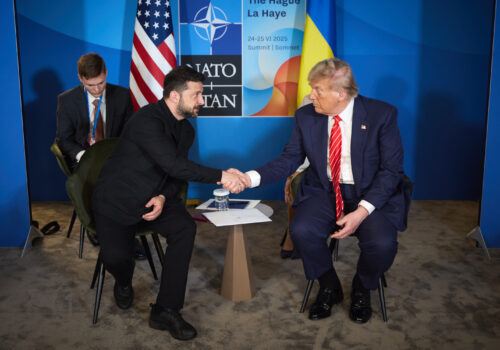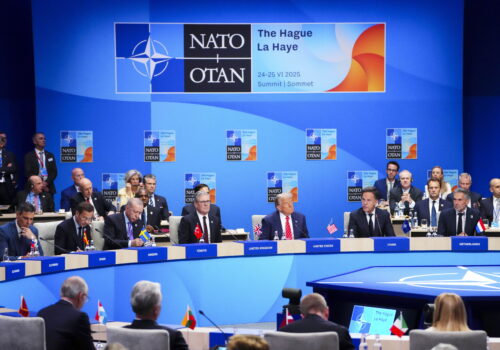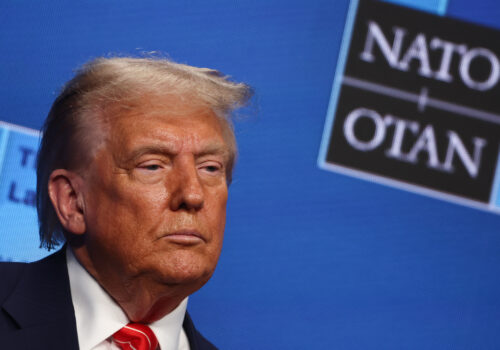NATO leaders are breathing a sigh of relief after a smooth summit in The Hague that projected allied unity and secured a new defense spending pledge. But the harmonious summit is actually an indication of its failure to address any of the hard questions facing the Alliance. Over the coming months, NATO allies will have to wrestle with several difficult but fundamental questions: How committed is the United States to European security? Will US President Donald Trump apply more pressure on Russia? Will the United States continue to support Ukraine? Can allies find a common approach to China?
That’s not to say the summit achieved nothing. To appease Trump’s demands that allies spend more on their own defenses, they agreed on an impressive new defense spending pledge. The pledge raises the bar from the current threshold of spending 2 percent of gross domestic product on defense to a whopping 5 percent over the next decade—with 3.5 percent devoted to military equipment and another 1.5 percent for defense-related priorities such as critical infrastructure and cybersecurity. In this regard, The Hague summit was a success.
However, unlike summits in the past three years, when supporting Ukraine against Russia’s ongoing invasion took center stage, allies determined in advance of the summit that they would not announce any new support measures for Ukraine. Nor would they invite Ukrainian President Volodymyr Zelenskyy to attend any official summit sessions. At Washington’s insistence, NATO also scrapped its earlier plans to release a tougher NATO strategy on Russia, meant to replace the one adopted in the 1990s when NATO viewed Russia as a potential partner.
Mercifully short at just five paragraphs, the summit declaration does not highlight the immediate threat Moscow’s military reconstitution poses to the Alliance, noting instead the “long-term threat” Russia poses to Euro-Atlantic security, alongside the threat of terrorism. It does not mention how Russia’s full-scale invasion of Ukraine—the largest land war in Europe since World War II—has shattered peace and stability in the Euro-Atlantic. It does not address China’s stated ambitions or policies that challenge transatlantic security and values. Nor does it note the importance of strengthening NATO’s relationship with its Indo-Pacific partners. The declaration solidifies that this was a “hear nothing, see nothing, say nothing” summit meant to project a sense of calm amid an increasingly volatile and violent security landscape.
Opting not to address the toughest challenges facing the Alliance will come at a high price. Instead of agreeing to a robust set of deliverables that will strengthen NATO’s deterrence and resolve, allies will be left to their own national devices at a time when the full weight of the Alliance is needed to address threats and challenges to their security. NATO leaders are now left to confront four major uncertainties when they return to their capitals. Taken together, they present an immense task for the Alliance in the months and years ahead.
How committed is the United States to European security?
The first unknown is the United States’ political and military commitment to the transatlantic relationship. Despite reassuring comments from Trump at the close of the summit, several instances have highlighted this administration’s deep antipathy toward its European allies and partners. Trump has a long track record of skepticism toward multilateral institutions, including NATO. He has also said that Russian President Vladimir Putin and Russia should “do whatever the hell they want” to those allies that do not pay enough for their defense. And he has repeatedly questioned whether the United States should live up to its Article 5 collective defense commitments.
More recent examples include Trump’s pause of US military assistance and intelligence sharing to Ukraine, Vice President JD Vance’s scathing speech at the Munich Security Conference in February, and the infamous “Signalgate” text exchange, in which Vance and Secretary of Defense Pete Hegseth called Europeans “free-loaders” and “pathetic.” As a result, it’s no surprise that European leaders have indicated that Trump’s second arrival in the White House has ushered in a new era for the transatlantic relationship, in which Europeans cannot fully trust or rely on the United States.
The United States’ conventional military commitment to Europe is also in question. At this year’s summit, allies agreed to new capability targets to meet requirements outlined in NATO’s defense plans. However, these decisions were taken before the United States Department of Defense has completed its Global Posture Review, which is expected later this year. This review will assess and then recommend where the United States should locate its troops and capabilities around the world.
Early indications are that the United States will look to shift a significant number of troops and capabilities out of Europe and into theaters the administration deems more critical to US national security, including the Indo-Pacific and the Middle East. While any changes to the United States’ conventional force posture in Europe won’t change the overall capabilities that NATO needs to deter and defend, a large-scale shift could overwhelm European allies that have not planned for an abrupt and significant drawdown.
Will Trump apply more pressure on Russia?
Another unknown is whether the United States will increase costs on Russia for its continued aggression in Ukraine. Despite Trump’s frustration with Putin, he has yet to say if he will penalize the Kremlin for pulling the United States along through futile negotiations meant to distract from Russia’s ongoing bombardment of Ukrainian civilians and critical infrastructure. Congress is deliberating on a new sanctions bill to target Russian energy exports (with eighty-four senators as cosponsors), but the White House has not indicated that it will support these measures. As the European Union assesses whether to renew its economic and energy sanctions on Moscow, a return to business as usual between United States and Russia would render Europe’s efforts meaningless.
Will the United States continue to support Ukraine?
Third, it remains unclear whether Trump will wash his hands of the conflict in Ukraine—now in its fourth year—and forego any future rounds of much-needed security assistance to Kyiv. The United States’ shift away from supporting Ukraine is already happening. In addition to the administration’s earlier pause of assistance and intelligence sharing to Ukraine, the United States has abdicated its leadership of the Ukraine Defense Contact Group—the very forum the United States launched and led for over three years to coordinate security assistance from more than fifty countries to Ukraine. Not knowing whether the United States will remain by Ukraine’s side puts another potential strain on European resources, which already may be squeezed by a retreating US force posture in Europe.
Can allies find a common approach to China?
Lastly, the Trump administration is sending mixed signals to European allies and partners about its interest in pursuing a common approach toward China. This uncertainty led allies to forego an important opportunity in The Hague to address the complex and growing challenges that China poses to Euro-Atlantic security. Moreover, the leaders of three of NATO’s Indo-Pacific partners—Japan, South Korea, and Australia—decided to forego attending the summit. This signals a setback in the momentum the first Trump administration and Biden administration made in strengthening coordination between Europeans and other democratic allies to address Chinese military assertiveness in the Indo-Pacific, economic coercion, and technological influence in Europe. This wavering could not come at a worse time, as Beijing continues its support of Russia’s aggression in Ukraine and attempts to exert influence over democratic states in Europe and the Indo-Pacific.
None of these pressing questions was adequately answered by allied leaders at this year’s NATO Summit. Yet how these challenges play out in the coming months and years will fundamentally shape NATO’s ability to address existing and emerging threats to Alliance territory. Allied leaders may have secured a new spending pledge and a nice photo op in The Hague, but a lot of hard work and harsh realities are waiting for them as they return home.
Torrey Taussig is a director and senior fellow at the Transatlantic Security Initiative in the Atlantic Council’s Scowcroft Center for Strategy and Security. She was previously a director for European affairs on the National Security Council and the Department of Defense coordinator for the 2024 NATO Summit.
Further reading
Fri, Jun 27, 2025
Trump’s approach to Russia and its war on Ukraine is evolving, not in one big leap, but in several smaller steps
New Atlanticist By John E. Herbst
Both Trump’s strikes on Iran and his statements at the NATO Summit signaled an evolution toward a tougher line on Moscow.
Wed, Jun 25, 2025
Experts react: NATO allies agreed to a 5 percent defense spending target in a low-drama summit. Now what?
New Atlanticist By
The Alliance summit was notable for what was said and done, especially about defense spending—but also for what was left off the agenda.
Wed, Jun 25, 2025
Trump warmed to NATO at The Hague. But what about Ukraine?
Fast Thinking By
Allies reiterated their commitment to collective defense. But absent from the communiqué was any mention of how Russia’s war against Ukraine should end.
Image: US President Donald Trump and NATO Secretary General Mark Rutte attend the start of a NATO leaders summit in The Hague, Netherlands June 25, 2025. Ludovic Marin/Pool via Reuters.




